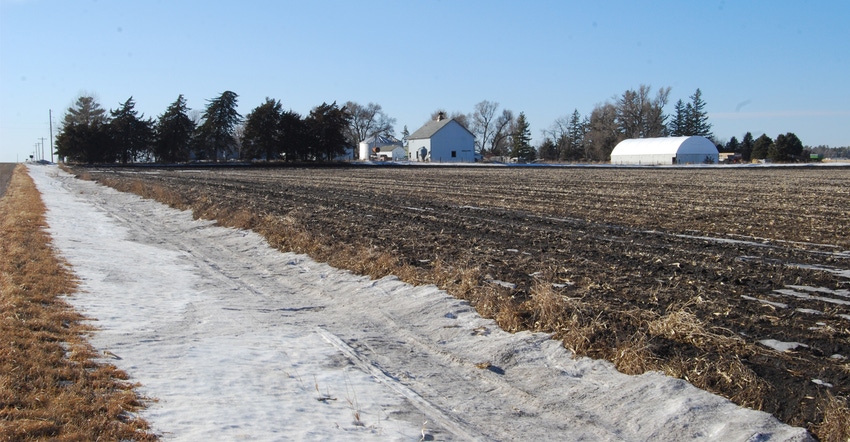
Soils throughout Iowa and in other Midwest states are drier than normal this winter. Subsoil moisture in the top 5 feet of soil is below average. And temperatures have been extremely cold this winter — definitely below average.
Dennis Todey, director of the USDA Midwest Climate Hub at Iowa State University in Ames, says, “With dry soils we have the chance of frost depths penetrating quite a bit deeper than we are used to during winter. We saw this back in 2014 with water lines freezing in some parts of the upper Midwest.”
The extreme cold of the last couple weeks has brought tough conditions for humans and animals alike. Iowa hasn’t seen such extreme and persistent cold in a number of years. The cold can bring unseen problems below the soil surface as the frost depth in the soil deepens, Todey says. Cold temperatures set in across central Iowa before snow covered the soil. Without that insulating effect, soils were able to freeze more readily.
Deep freeze for soil
“Most soils in our area were fairly dry, thus allowing the soil to freeze deeper and more easily than normal,” says Mark Johnson, ISU Extension field agronomist in central Iowa. “Dry soils cool more rapidly because of lack of water, which has a high heat content. With the consistent extreme cold and cold temperatures likely continuing in January, frost depths will continue to penetrate deeper.”
The National Weather Service has a map of frost depths.
Click on the icon in the black bar just above the map to see the legend for the map.
“Frost depths are mainly less than 2 feet deep in Iowa now,” Johnson says. “The early-winter warmth in December may have helped limit problems by keeping the soils warmer, but conditions should be monitored for ongoing issues. The cold takes time to penetrate to deeper soil depths. This, in turn, can cause problems for water supplies for livestock [frozen waterlines and waterers] and for homes [frozen waterlines], if the severe cold continues.”
Midwest Climate Hub website
Upper Midwest states also have their own soil networks at the Midwest Climate Hub.
The link to Iowa’s 4-inch soil temperatures map is just below the map at the previously mentioned website. “This state map at this website doesn’t give freezing depth, but it does give you some idea of the change which allows you to make an educated guess. Using the two sites together should be helpful,��” Johnson says.
Freeze-thaw cycles helpful
As far as freeze-thaw cycles’ effect on the soil, the more they occur, the more they can help break up soil compaction left from the previous crop year, Johnson says. “However, these cycles only help break up the compaction down to a depth of about 4 or 5 inches.”
The possibility of dry weather in the 2018 growing season is also attracting attention. Drought levels nationwide are trending near 12-month highs. For the third week in a row at the end of December, more than half of the U.S. is enveloped in drought, according to the latest U.S. Drought Monitor.
Dry conditions as 2018 begins
A drier-than-normal weather pattern in Iowa, which began in late October, continued through December and is moving into January. The latest information from the Climate Prediction Center indicates total moisture in the top 5 feet or so of soil is as much as 3 to 4 inches below normal in parts of southeast Iowa. In areas farther to the west and north, it isn’t quite that dry, but total soil moisture is still below normal. In western Iowa, subsoil moisture amounts are closer to normal, but the topsoil is dry in most areas.
“Going further into winter, these soil moisture deficits won’t be replenished to any great degree, and some areas will still have significant deficits when spring arrives ahead of the 2018 growing season,” says ISU Extension climatologist Elwynn Taylor.
La Niña conditions continue
During La Niña years, the risk of serious drought occurring in the U.S. Corn Belt increases. In the Pacific Ocean near the equator, weak La Niña conditions have continued since developing late last summer and into fall, Taylor says. For a brief period of time, La Niña was moderate strength, but it mostly has stayed in the weak category.
In winters with weak-to-moderate La Niña conditions, temperature for January and February shows a trend to near normal or below normal in Iowa, Taylor says. Precipitation trends in these years don’t vary greatly from normal. There were some winters that didn’t follow these trends, and each winter is different.
Normal January precipitation ranges from 0.5 to 0.75 inch in much of northwest and in west-central Iowa, and up to 1.25 to 1.5 inches in some of the far eastern, central and southeast parts of the state. Normal snowfall is 6 to 9 inches in much of western Iowa into the southern three-fourths of Iowa, and up to 9 to 12 inches in much of northeast and parts of north-central Iowa.
About the Author(s)
You May Also Like




